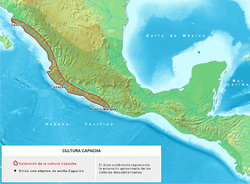 Capacha culture extension Map | |
 Interactive map of Complejo Capacha | |
| Location | Colima, Colima |
|---|---|
| Region | Mesoamerica |
| Coordinates | 19°16′54″N103°41′28″W / 19.28167°N 103.69111°W |
| Type | Mesoamerican archaeology |
| History | |
| Founded | 2000 to 1000 BCE |
| Periods | Mesoamerican Preclassical, Classical, Postclassical |
| Cultures | Capacha |
Capacha is an archaeological site located about 6 kilometers northeast of the Colima Municipality, in the Mexican state of Colima. This site is the heart of the ancient Mesoamerican Capacha Culture.
Contents
- Background
- Culture origin
- Discovery
- Capacha Culture
- Cultural Stages
- Cultures Chronology
- El Opeño
- La Campana
- Los Ortices Complex
- Armería & Colima Complex
- El Chanal Complex
- Important Aspects
- Capacha Ceramic
- Shaft Tombs
- South America
- Notes
- See also
- References
- Bibliography
- External links
The Capacha Culture peoples were located between the Jalisco Sierra Madre Occidental and the Colima Valley. Several sites in the region have relations with Capacha, such as the Embocadero II site (800 BCE) in the Mascota Valley, which has a background with the shaft tomb tradition. There is also evidence of green stone articles, Jadeite cylindrical beads and possibly Amazonite, as well as Turquoise fragments. [1] [2]
It is known there were close relations between Capacha and El Opeño, by the existing ceramic relationship between types red zonal and dark red/beige, as well as similarities between figurine types of both complexes. [2] [3]
This information is corroborated by Opeño style figurines and Capacha type ceramic found in the area of Tuxpan - Tamazula - Zapotlán; [4] as well as in other places in Jalisco, where shaft tombs similar to El Opeño and ceramic vessels similar to Capacha were found. [2] [5]
In addition, the culture and Capacha had some kind of contact with cultures of the Center of Mexico, e.g. Tlatilco, between 1300 and 900 BCE, which probably had a higher level of development at that time. Beatriz Braniff and other researchers pointed the presence of a "tertium quid" in central Mexico differentiated from Olmec traditions and the center of Mexico, whose origin was the western region. [2] [6]
